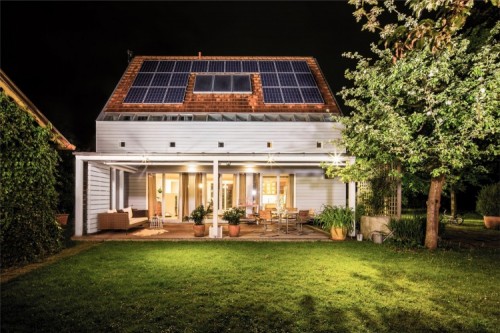
Image: E.On.
The energy performance of a home can now be used by mortgage lenders to determine if higher levels of finance can be provided to new homeowners, creating an impetus for buyers and house builders increase energy efficiency and savings in their homes.
The Lenders project was launched in late 2015 by a consortium of partners spearheaded by Innovate UK, Nationwide Building Society and the UK Green Building Council.
It set out to demonstrate that improved analysis of likely household energy costs could improve mortgage affordability assessments, potentially allowing mortgage borrowers to access a larger home loan.
Reporting today after analysing 40,000 sets of property data, the project has concluded that more accurate assessments could vary maximum loans by up to £11,500 between the most efficient properties and the most energy hungry homes.
Andrew Sutton, associate director of the Building Research Establishment (BRE) which also took part in Lenders, said: “Our research indicates that low energy homes potentially enable homebuyers to borrow more than those buying poor performing homes. Put simply, energy efficiency brings smaller energy bills, which if captured when calculating mortgage affordability could allow buyers to take out a larger loan.”
By successfully demonstrating a link between energy efficiency and household fuel bills, the report also suggests that the same change in forecasting could release thousands of pounds for those undertaking refurbishments, providing a new economic incentive for solar and other energy saving installations.
Henry Jordan, director of mortgages at Nationwide Building Society said: “The Lenders project has developed a valuable tool that could help customers forecast their future home’s energy costs. The work highlights the impact of home efficiency on fuel costs and presents a potential opportunity for lenders to support customer’s home and environmental ambitions and to improve the UKs energy performance.”
Speaking on behalf of the government to reflect its involvement in the project, climate change minister Claire Perry heralded Lenders for its potential to boost home ownership.
“More accurate estimates of household energy costs could improve lending practices, lead to new sources of finance and increase energy efficiency across the country. That's why government funded this project through Innovate UK and looks forward to seeing the industry take action in response,” she said.
Following the policy shift away from domestic energy efficiency, particularly for what has been dubbed the ‘able-to-pay’, private sector firms have begun to pick up the slack left by government. New loans under the Green Deal Finance Company are now available following the acquisition of the government scheme by City investors Greenstone Finance and Aurium Capital Markets, while the likes of E.On and EDF have begun offering solar.
Following cuts to the available subsidies for domestic solar, domestic deployment has struggled to recover. However, growing recognition of the technology’s ability to save homeowners cash is starting to build renewed interest in solar.
A recent study by E.On found that four in ten (44%) said they’d like solar panels and/or an electricity battery storage system by the end of the decade, with two thirds of those asked who already have solar saying it had made their homes more energy efficient.

